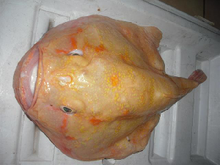
Deep-sea fish are fish that live in the darkness below the sunlit surface waters, that is below the epipelagic or photic zone of the sea. The lanternfish is, by far, the most common deep-sea fish. Other deep sea fishes include the flashlight fish, cookiecutter shark, bristlemouths, anglerfish, viperfish, and some species of eelpout.
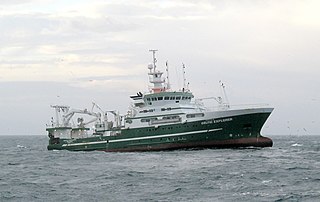
Bottom trawling is trawling along the seafloor. It is also referred to as "dragging". The scientific community divides bottom trawling into benthic trawling and demersal trawling. Benthic trawling is towing a net at the very bottom of the ocean and demersal trawling is towing a net just above the benthic zone. Bottom trawling can be contrasted with midwater trawling, where a net is towed higher in the water column. Midwater trawling catches pelagic fish such as anchovies and mackerel, whereas bottom trawling targets both bottom-living fish (groundfish) and semi-pelagic species such as cod, squid, shrimp, and rockfish.

Members of the genus Lophius, also sometimes called monkfish, fishing-frogs, frog-fish, and sea-devils, are various species of lophiid anglerfishes found in the Atlantic and Indian Oceans. Lophius is known as the "monk" or "monkfish" to the North Sea and North Atlantic fishermen, a name which also belongs to Squatina squatina, the angelshark, a type of shark. The North European species is Lophius piscatorius, and the Mediterranean species is Lophius budegassa.

Pelagic fish live in the pelagic zone of ocean or lake waters—being neither close to the bottom nor near the shore—in contrast with demersal fish that do live on or near the bottom, and reef fish that are associated with coral reefs.

Demersal fish, also known as groundfish, live and feed on or near the bottom of seas or lakes. They occupy the sea floors and lake beds, which usually consist of mud, sand, gravel or rocks. In coastal waters they are found on or near the continental shelf, and in deep waters they are found on or near the continental slope or along the continental rise. They are not generally found in the deepest waters, such as abyssal depths or on the abyssal plain, but they can be found around seamounts and islands. The word demersal comes from the Latin demergere, which means to sink.

The footballfish form a family, Himantolophidae, of globose, deep-sea anglerfishes found in tropical and subtropical waters of the Atlantic, Indian, and Pacific Ocean. The family contains about 22 species all in a single genus, Himantolophus.

The sea toads and coffinfishes are a family of deep-sea anglerfishes known as the Chaunacidae.

The pink frogmouth or redeye, Chaunax pictus, is a sea toad of the family Chaunacidae, found around the world on continental shelves in tropical and temperate waters, at depths of between 200 and 660 m. Its length is up to 40 cm. It can be distinguish from present species with a black, deeply concave illicial cavity, and an esca that is black anterodosally and pale or white posteroventrally.
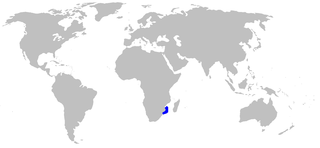
The balloon shark is a species of catshark, and part of the family Scyliorhinidae, endemic to the southwestern Indian Ocean off South Africa and Mozambique. Benthic in nature, it is found over sandy and muddy flats at depths of 40–600 m (130–1,970 ft). This thick-bodied species has a broad, flattened head and a short tail; its distinguishing traits include narrow, lobe-like skin flaps in front of the nostrils, and a dorsal color pattern of faint darker saddles on a light grayish background.
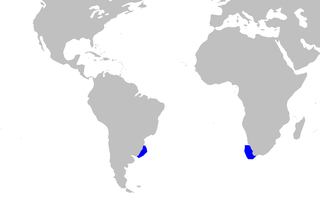
The taillight shark is a little-known species of shark in the family Dalatiidae and the only member of its genus. It is known from only four specimens collected from deep oceanic waters in the southern Atlantic Ocean and Pacific Ocean. A small shark with a laterally compressed body and a bulbous snout, this species has unusual adaptations that indicate a specialized lifestyle: its pectoral fins are paddle-like and may be used for propulsion, unlike other sharks and it has a pouch-like gland on its abdomen that emits clouds of luminescent blue fluid. This shark is likely aplacental viviparous and a formidable predator for its size.
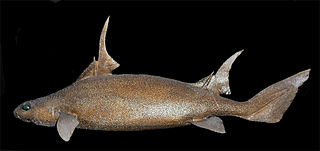
The sailfin roughshark is a species of dogfish shark in the family Oxynotidae, found in the eastern North Atlantic from Scotland to Senegal between latitudes 61°N and 11°N, at depths of between 265 and 720 m. Its length is up to 1.2 m (3.9 ft).

A bottom feeder is an aquatic animal that feeds on or near the bottom of a body of water. Biologists often use the terms benthos—particularly for invertebrates such as shellfish, crabs, crayfish, sea anemones, starfish, snails, bristleworms and sea cucumbers—and benthivore or benthivorous, for fish and invertebrates that feed on material from the bottom. However the term benthos includes all aquatic life that lives on or near the bottom, which means it also includes non-animals, such as plants and algae. Biologists also use specific terms that refer to bottom feeding fish, such as demersal fish, groundfish, benthic fish and benthopelagic fish. Examples of bottom feeding fish species groups are flatfish, eels, cod, haddock, bass, grouper, carp, bream (snapper) and some species of catfish and shark.

The western school whiting, also known as the banded whiting, golden whiting and bastard whiting, is a species of benthic marine fish in the smelt-whiting family Sillaginidae. The species is one of three 'school whiting' that inhabit southern Australia and share a very similar appearance. Western school whiting are known to grow to 30 cm in length and 275 g in weight, although unconfirmed reports suggest this might be an underestimate. The western school whiting is distributed along the Western Australian coast from Maud Landing in the north to Rottnest Island in the south. The species inhabits both shallow inshore environments and waters to depths of 55 m. The species is a benthic predator, taking a variety of crustaceans, molluscs and echinoderms, and shows a change in diet with age and habitat. S. vittata is a multiple spawner, reproducing between December and February once it has reached one or two years of age. Juveniles inhabit protected inshore waters, moving offshore once they reach sexual maturity. It is often found in association with other sillaginids and comprises a minor fraction of commercial whiting catches in Western Australia.
Lophichthys boschmai, also known as Arafura frogfish or Boschma's frogfish, is a species of anglerfishes closely related to frogfish. L. boschmai is the only species in the Lophichthydae family. L. boschmai were first reported by Marinus Boseman in 1964 to the Rijksmuseum van Natuurlijke Historie, now known as National Museum of Natural History in Leiden. The species was named after Dutch zoologist, Hildbrand Boschma.

The redeye gaper, Chaunax stigmaeus, is a sedentary species of anglerfish in the family Chaunacidae. It is native to deep waters in the western North Atlantic from the Georges Bank off New England southward to the Blake Plateau off South Carolina. The species is found on the outer continental shelf and upper continental slope at a depth of 90–730 m and among dense beds of dead coral rubble, their preferred habitat. The original type specimen was caught in a trawl off Atlantic City on March 1, 1946, and donated to the Academy of Natural Sciences by Carroll B. Atkinson. The name stigmaeus means "speckled" in Greek.

The anglerfish are fish of the teleost order Lophiiformes. They are bony fish named for their characteristic mode of predation, in which a modified luminescent fin ray acts as a lure for other fish. The luminescence comes from symbiotic bacteria, which are thought to be acquired from seawater, that dwell in and around the sea.

The humpback anglerfish is a species of black seadevils in the family of Melanocetidae, which means "black whale" in Greek. The species is named after James Yate Johnson, the English naturalist who discovered the first specimen in Madeira in 1863. The common names include anglerfish, viperfish and fangtoothfish.

Chaunax is a genus of bony fish in the sea toad family Chaunacidae. They are found in tropical and subtropical oceans around the world and most species are found at depths between 180 and 1,100 m, but C. endeavouri occurs as shallow as 50 m (160 ft) and C. fimbriatus as deep as 1,985 m (6,512 ft). Depending on the exact species involved, they reach a total length of 11–40 cm (4.3–15.7 in).

Chaunacops is a genus of lophiiform fish (anglerfish) in the family Chaunacidae. They are characterized as having globose heads, open sensory and lateral line canals, and loose skin covered by small spine-like scales. Colour, which has been noted as an important distinguishing characteristic, has generally been described as pink, reddish orange, or rose. However, recent work by Lundsten et al. (2012) suggests that juvenile Chaunacops coloratus may be blue and only adults are red or rose coloured.
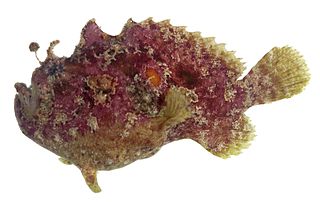
Antennatus coccineus, the scarlet or freckled frogfish, is a species of frogfish originally classified as Chironectes coccineus and Antennarius coccineus. It lives within tropical waters and has a central distribution being around Indo-East-Pacific areas- excluding Hawaii. The habitat of the scarlet frogfish is in the shallow zones of the ocean. It is found within reef areas, in rocky mounds or sponges where there are places for it to hide amongst from predators. The scarlet frogfish comes in a variety of colours, from tan and brown colours to bright reds and yellows and will grow to a maximum length of 13 centimetres (5.1 in). It can be identified taxonomically through its pectoral rays, the presence of dark patches that appear on its fins and body, along with its lack of distinctive tail base. The scarlet frogfish is not harmful to humans and is not caught by fisheries for consumption purposes, however it has been caught previously for studies relating to the abundance of reef-dwelling fish and as bycatch of shrimp trawling. Similar to other frogfish species, the scarlet frogfish is a predatory carnivore and exhibits a low degree of sociality, only interacting with other scarlet frogfish during their mating period.
